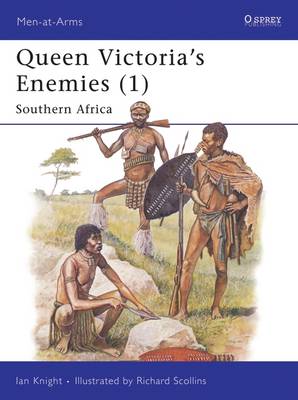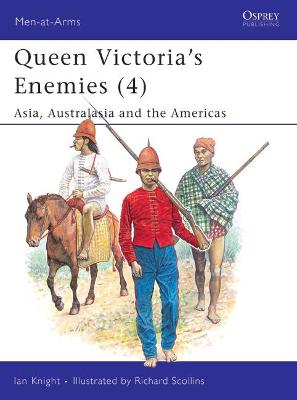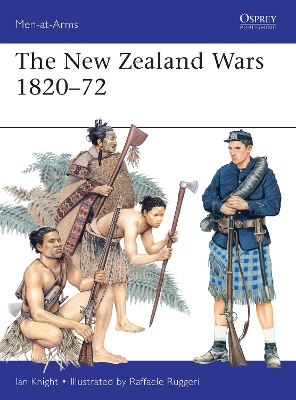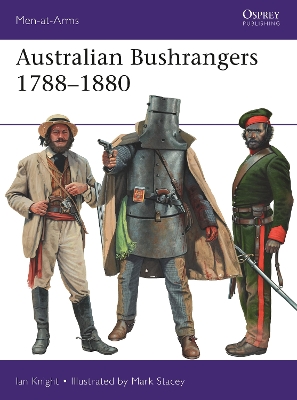Men-at-Arms
4 primary works • 5 total works
Book 212
When Queen Victoria acceded to the British throne in 1837, British troops had recently concluded a war in southern Africa against the Xhosa people, and the seeds were already sown for a clash with the Boers. When she died in January 1901 Britain was fighting the Boers in one of the longest and costliest of the imperial colonial wars. This book details the history of Britain's numerous conflicts with the people of southern Africa, namely the Xhosa, Basotho, Tswana and Boers. Numerous illustrations, including rare photographs and colour plates, detail the dress, weaponry and organization of Victoria's enemies in the late 19th century.
Book 215
Due to the spread of British strategic and commercial interests during the Victorian period, the British military was called upon to serve in theatres across the world. Some of the fighting was severe; it took nearly 30 years of intermittent warfare to suppress Maori opposition to settler expansion in New Zealand. In other areas it amounted to little more than skirmishing, as in Brooke's campaign against the pirates of Borneo and the Jamaican revolt of 1865. This book details these various 'small wars' and examines the qualities of the disparate peoples who opposed the spread of the British Empire.
Book 303
On 11 October 1899 the Second Boer War between the British and the Boers began. The war saw the most powerful professional army in the world pitted against the unconventional tactics of the undisciplined Boers. Although the Boers were finally forced to surrender in May 1902 the war had taken its toll on their opponents who lost some 8,000 troops killed in action with a further 13,000 dying from disease. This book covers the organisation, uniforms and very different tactics involved in the conflict, from guerrilla warfare to a final war of attrition that the Boers could not hope to win.
Book 487
Between 1845 and 1872, various groups of Maori were involved in a series of wars of resistance against British settlers. The Maori had a fierce and long-established warrior tradition and subduing them took a lengthy British Army commitment, only surpassed in the Victorian period by that on the North-West Frontier of India. Warfare had been endemic in pre-colonial New Zealand and Maori groups maintained fortified villages or pas. The small early British coastal settlements were tolerated, and in the 1820s a chief named Hongi Hika travelled to Britain with a missionary and returned laden with gifts. He promptly exchanged these for muskets, and began an aggressive 15-year expansion. By the 1860s many Maori had acquired firearms and had perfected their bush-warfare tactics. In the last phase of the wars a religious movement, Pai Maarire ('Hau Hau'), inspired remarkable guerrilla leaders such as Te Kooti Arikirangi to renewed resistance. This final phase saw a reduction in British Army forces. European victory was not total, but led to a negotiated peace that preserved some of the Maori people's territories and freedoms.
The first 'bushrangers' or frontier outlaws were escaped or time-expired convicts, who took to the wilderness - 'the bush' - in New South Wales and on the island of Tasmania. Initially, the only Crown forces available were redcoats from the small, scattered garrisons, but by 1825 the problem of outlawry led to the formation of the first Mounted Police from these soldiers.
The gold strikes of the 1860s attracted a new group of men who preferred to get rich by the gun rather than the shovel. The roads, and later railways, that linked the mines with the cities offered many tempting targets and were preyed upon by the bushrangers.
This 1860s generation boasted many famous outlaws who passed into legend for their boldness. The last outbreak came in Victoria in 1880, when the notorious Kelly Gang staged several hold-ups and deliberately ambushed the pursuing police. Their last stand at Glenrowan has become a legendary episode in Australian history. Fully illustrated with some rare period photographs, this is the fascinating story of Australia's most infamous outlaws and the men tasked with tracking them down.
The gold strikes of the 1860s attracted a new group of men who preferred to get rich by the gun rather than the shovel. The roads, and later railways, that linked the mines with the cities offered many tempting targets and were preyed upon by the bushrangers.
This 1860s generation boasted many famous outlaws who passed into legend for their boldness. The last outbreak came in Victoria in 1880, when the notorious Kelly Gang staged several hold-ups and deliberately ambushed the pursuing police. Their last stand at Glenrowan has become a legendary episode in Australian history. Fully illustrated with some rare period photographs, this is the fascinating story of Australia's most infamous outlaws and the men tasked with tracking them down.




